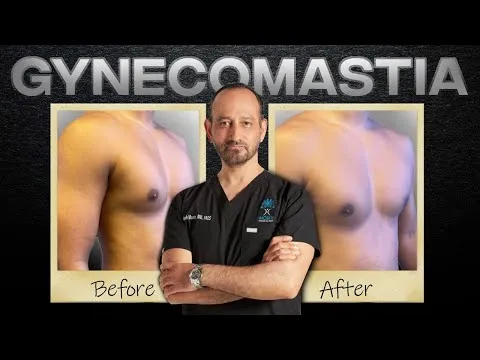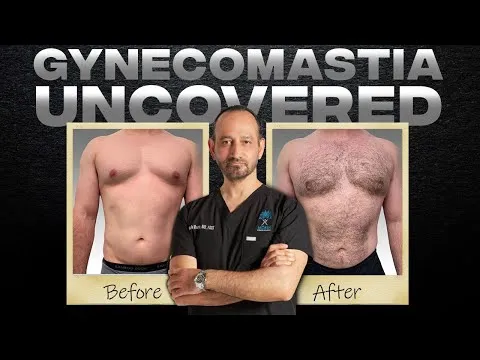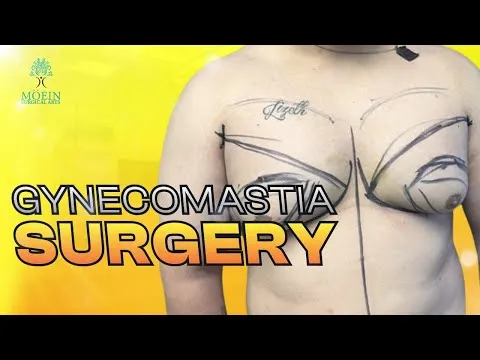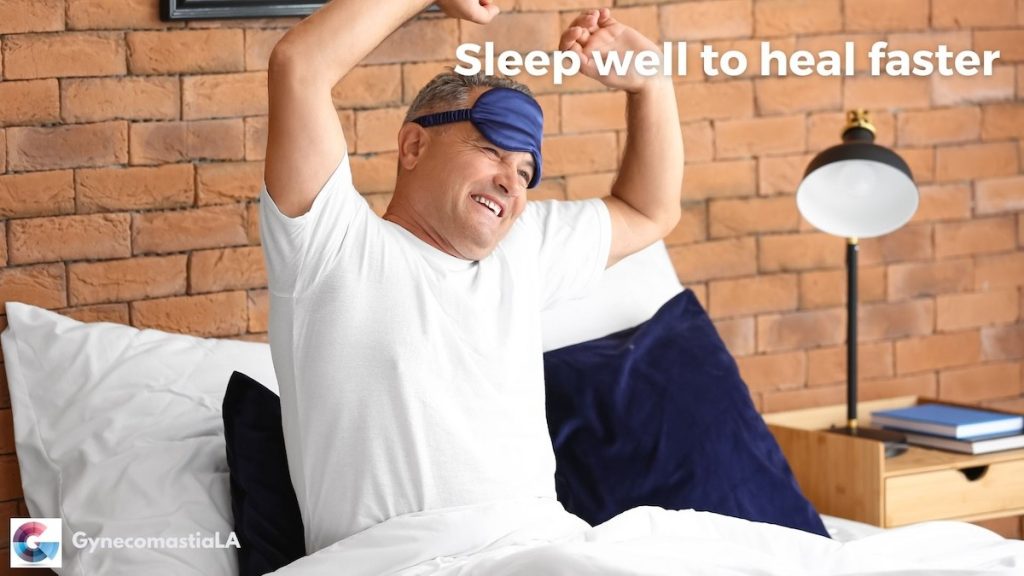Gynecomastia can be referred to by many names, some of them downright crude (the term “man boobs” comes to mind), and there are types and grades of Gynecomastia too. If you asked the average person on the street, they would admit to believing that gynecomastia is a rare condition. The excess breast tissue leads to female-like breasts appearing in over half of all men.
The condition can appear in infants, pubescent boys, and older men. For many, the breast growth goes away on its own. Only gynecomastia surgery can permanently correct the condition when the condition persists, leading to diminished self-esteem. The cause of gynecomastia is typically an imbalance between the male and female hormones (testosterone vs. androgens), leading to excess breast growth. Other causes include prescription drugs,
illicit drug use, steroid abuse, and some diseases. Gynecomastia doesn’t always look the same in every male who experiences the condition. Some men have minor gyno, while others have severe gynecomastia miming female breasts. Scientists have devised a grading system to help diagnose men with the condition. The types and grades of Gynecomastia will determine the proper course for treatment.
The Types and Grades of Gynecomastia are as follows:
Grade 1: Small Breast Enlargement Without Excess Skin
This type and grades of Gynecomastia is considered minor, meaning a slight amount of breast growth sticks out from the chest. In most cases, you might not be able to tell if the boy or man has gynecomastia while clothed, while others may have breasts that do show through clothing.
Asymmetry may also be present, where one breast is slightly larger than the other. For grade 1 gynecomastia, breast reduction or gynecomastia surgery can be a solution when the breast growth persists.
Surgery may also help treat any psychological issues due to the breast growth condition. For grade one gyno, surgery tends to produce very successful outcomes.

Grade 2: Moderate Breast Enlargement without Excess Skin
The types and grades of Gynecomastia, considered a moderate form of breast enlargement, is categorized by breast growth that expands broadly across the chest. The growth tends to stop at the width of the chest, going no further. Grade two can be very noticeable in T-shirts, contributing to psychological and social issues.
The best treatment for grade two gyno tends to be breast surgery reduction. This consists of mammary gland incision and liposuction to remove the excess fat. As with grade one, surgery tends to produce favorable results.

Grade 3: Moderate Breast Enlargement with Excess Skin
Also considered a moderate form of breast growth, grade three types and grades of Gynecomastia is identified by significant breast enlargement. With this types and grades of Gynecomastia, the breast tissue swells and expands beyond the width of the chest. For this grade to manifest, there needs to be at least some amount of excess skin, which is very noticeable, even when clothed. Surgery is the only form of treatment that can treat grade three of gynecomastia, producing more masculine results.

Grade 4: Significant Breast Enlargement with Excess Skin
Grade four Gynecomastia is identified by severe breast enlargement with substantial extra skin. The breasts tend to be highly visible and can mimic female breasts. Surgery is the only form of treatment and can reduce male breasts to a more normal contour.

How Does Each Gynecomastia Grade Form?
Hormone imbalances, illegal drug use, and steroid abuse are some causes that can lead to a gynecomastia condition. Other factors can also determine how severe the condition can become.
Age
The older you are, the less elastin and collagen your skin possesses. Without these elements, the skin can begin to break down, leading to sagging on or around the chest. The aging process can exacerbate male gyno, potentially advancing your types and grades of Gynecomastia.
Genetics
Gynecomastia can run in your family. If your family members have any form of the condition, you may have it too. Yours may not look exactly like theirs, but the condition can be present, and surgery can help.
Weight Gain
Sun Damage
Extreme sun exposure can further sap the skin of vital components like elastin and collagen. Not only can an overabundance of sun give you sun spots or a leathery appearance, but the ultraviolet light can also break down skin cells over time. This can lead to an even greater amount of sag and a worsening of your gyno symptoms.
Is Gynecomastia Surgery Necessary?
Now that you know more about the types and grades of Gynecomastia and how surgery can treat your condition, you may think about surgery, but you’re still not convinced. This is perfectly normal, as surgery is a major decision, no matter if you have a minor or severe form of the condition.
A common question is: Can gynecomastia ever harm my health? The answer is that unless the condition is caused by something other than gyno – male breast cancer, for example – then no, gynecomastia usually won’t cause pain. Nor is gyno likely to limit your life in any significant way.
There is a caveat there. If the male breasts rub against your skin, you might form rashes that can become infected. The male breasts may also tug on the muscles that support your neck and back, leading to poor posture and other harmful outcomes.
Then, there is the psychological pain that comes with having male gynecomastia. Now that you know which types and grades of Gynecomastia you have, you should know that millions of other men are similarly suffering. They, too, become very choosy about what they wear so as not to accentuate their chests. They are hesitant to strip off their shirts to swim or play sports out of fear of being mocked.
These are just two examples of how gynecomastia can cause discomfort to any degree, no matter the types and grades of Gynecomastia. Cosmetic breast reduction surgery can help.
How Can Surgery Help with My Grade of Gynecomastia?
Gynecomastia surgery can remove the excess breast tissue to restore your chest’s contours to a normal shape. Imagine being able to wear any type of shirt, knowing you’ll look just like every other man. If you work hard to build up your chest in the weight room, picture yourself flexing without the extra fat clinging to your pecs.
Even if you have a minor form of gynecomastia, such as grade one or two, you can boost your self-esteem to immense levels simply by undergoing a simple breast reduction.
How is Breast Reduction Surgery Performed In & Near Los Angeles?
What is Recovery Like After Breast Reduction Surgery?
You will do most of your recovery at home following your gynecomastia procedure. During this time, doctors may ask you to wear a compression garment. This constricting vest improves your circulation and offers support at the surgical site. You can take the garment off occasionally for hygiene purposes but wear it the rest of the time as directed to ensure you get the best results from your breast reduction.
Bruising and Swelling
You should expect to see bruises and swollen tissue around the surgical site during the gynecomastia surgery recovery. This is normal and is a result of the trauma inflicted during surgery. Any time tissue is cut or manipulated, bleeding, bruising, and swelling can result.
Your doctor will instruct you on properly caring for the surgical site to prevent infection until fully healed. You can also be proactive in adopting certain habits after surgery that can keep bruising and swelling and any discomfort to an absolute minimum. These include the following:
Keep Hydrated
You must remain hydrated during the recovery process. If you are dehydrated, your body may try to retain water, exacerbating swelling. To keep swelling to a minimum and initiate rapid healing, keep your body hydrated by drinking at least eight cups of water daily.
Sleep Well
The quality of your sleep will also determine how quickly and well you heal. Getting a full night of rejuvenating sleep each night is critical to your body’s natural healing process. To improve the quality of your sleep, make sure you sleep in a cool, dark room without distractions for at least six to eight hours per night.
Sleep Elevated
The way you sleep can help you heal faster and more thoroughly. Try to sleep on your back with your upper body elevated to around forty-five degrees. Sleeping this way ensures you won’t pull against the surgical site while you slumber. This sleep position also pulls blood away from the surgical site, which minimizes bruising.
Eat Healthily
You may want to reach for comfort foods while recovering from surgery, but you’re better off stocking your fridge and pantry with nutritional foods.
If you want to keep bruising to a minimum, fill your plate with more leafy greens, which are rich in vitamin K. These foods make your blood thicker, which can cut down on bleeding and bruising.

How Long Does Gyno Surgery Recovery Last?
Following your doctor’s advice, you could return to your usual activities in just a couple of weeks following gyno surgery. Your doctor will advise you not to lift heavy weights for a few weeks afterward, to make sure you don’t pull against the surgical site.
The chest will remain tender for some time when the male breasts are excised or excess fat is suctioned away, but all should be healed within 6 to 8 weeks. Your recovery period may vary depending on how fast your body heals.
Are There Any Risks to Gynecomastia Treatment?
As with any cosmetic surgery (or a surgical procedure of any other kind), gynecomastia surgery does have risks. You can minimize your level of risk by choosing a skilled and experienced gynecomastia surgeon.
The best gynecomastia surgeon for your case will be one who can show before and after of gynecomastia surgery pictures to prove they can restore your chest contours to a more normalized shape.
Potential risks of gyno surgery include infection, bleeding, excess bruising, breast asymmetry, and an unfavorable outcome. It is better to ask about potential risks to your health during the safe and private consultation with your gyno surgeon.
How Much Does Gynecomastia Surgery Cost?
You may be surprised to know that gynecomastia surgery only costs $6,239, according to the American Society of Plastic Surgeons. Compared to other cosmetic surgeries, gyno surgery is one of the least expensive, and most patients are very satisfied with their results. However, demographics can affect pricing, and additional procedures like liposuction may not be factored in.
When you consider the boost of confidence you can gain from male gyno surgery and the increase in your quality of life, you’ll see that gynecomastia surgery is well worth it, no matter your gyno grade.
Learn more about gynecomastia and what it can do for you by calling the Gynecomastia Center of Los Angeles at +1-310-694-4486, home of esteemed gynecomastia surgeon Dr. Babak Moein. Fill out the form for your no-obligation, personalized consultation today!
Read more:
Scar Massaging After Gynecomastia Surgery

Dr.Babak Moeinolmolki
LA Cosmetic Surgeon Dr. Moein is board-certified by the American Board of General Surgery.
